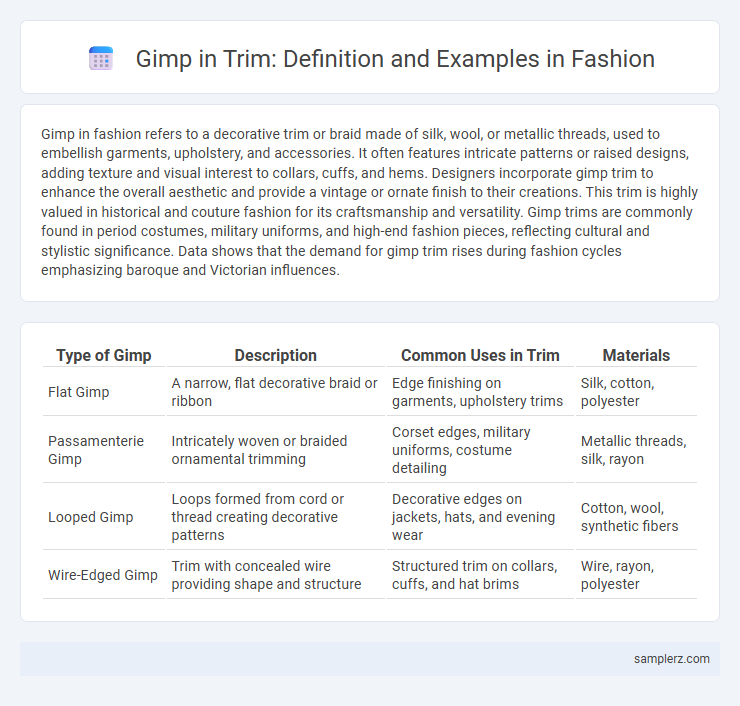Gimp in fashion refers to a decorative trim or braid made of silk, wool, or metallic threads, used to embellish garments, upholstery, and accessories. It often features intricate patterns or raised designs, adding texture and visual interest to collars, cuffs, and hems. Designers incorporate gimp trim to enhance the overall aesthetic and provide a vintage or ornate finish to their creations. This trim is highly valued in historical and couture fashion for its craftsmanship and versatility. Gimp trims are commonly found in period costumes, military uniforms, and high-end fashion pieces, reflecting cultural and stylistic significance. Data shows that the demand for gimp trim rises during fashion cycles emphasizing baroque and Victorian influences.
Table of Comparison
| Type of Gimp | Description | Common Uses in Trim | Materials |
|---|---|---|---|
| Flat Gimp | A narrow, flat decorative braid or ribbon | Edge finishing on garments, upholstery trims | Silk, cotton, polyester |
| Passamenterie Gimp | Intricately woven or braided ornamental trimming | Corset edges, military uniforms, costume detailing | Metallic threads, silk, rayon |
| Looped Gimp | Loops formed from cord or thread creating decorative patterns | Decorative edges on jackets, hats, and evening wear | Cotton, wool, synthetic fibers |
| Wire-Edged Gimp | Trim with concealed wire providing shape and structure | Structured trim on collars, cuffs, and hat brims | Wire, rayon, polyester |
Understanding Gimp in Fashion Trim
Gimp in fashion trim is a narrow decorative braid or cord often used to enhance garment edges, upholstery, and accessories with textured detailing. This ornamental embellishment, typically made from silk, wool, or synthetic fibers, provides a three-dimensional effect and durability to hems, collars, and cuffs. Understanding gimp's role helps designers incorporate intricate accents that elevate the overall aesthetic and structural integrity of fashion pieces.
Historical Overview of Gimp Trim Usage
Gimp trim, characterized by its ornamental braid or cord, has been employed in fashion since the Middle Ages to embellish garments and accessories with intricate detailing. Historically, gimp trim adorned ecclesiastical vestments, military uniforms, and aristocratic attire, highlighting status and craftsmanship. Its revival during the Victorian era emphasized elaborate embellishments on dresses and upholstery, reinforcing its role as a symbol of luxury and refinement.
Popular Types of Gimp Trim in Fashion
Gimp trim, a decorative narrow braid or applique, enhances garments with textured edges in fashion design. Popular types of gimp trim include metallic thread gimp, used for luxurious embellishments on evening wear, and braided cotton gimp, favored for casual jackets and accessories. Velvet and lace-based gimps add tactile contrast, often featured in high-end couture and vintage-inspired collections.
Gimp Trim Applications on Garments
Gimp trim enhances garment details by adding textured borders using decorative braid or cord, elevating the overall aesthetic and craftsmanship. Commonly applied on collars, cuffs, and hems, gimp trims provide a luxurious finish to haute couture and vintage apparel. Its versatility allows designers to emphasize patterns and lines, making garments visually striking and uniquely tailored.
Decorative Techniques with Gimp Trim
Gimp trim, a narrow ornamental braid made from silk, wool, or metallic threads, enhances garment edges and adds intricate texture to collars, cuffs, and hems. Popular in haute couture and historical fashion, this decorative technique highlights embroidery and beadwork by framing patterns with dimensional detail. Skilled artisans use gimp trim in layering and scalloping methods to create visually striking accents that elevate overall garment aesthetics.
Materials Commonly Used for Gimp Trim
Gimp trim often features materials such as metallic threads, rayon, and polyester to create intricate decorative patterns with a raised texture. Cotton and wool blends are also popular for gimp trims due to their durability and ability to hold detailed designs on garments and upholstery. These materials enhance the visual appeal and structural integrity of gimp embellishments in fashion design.
Modern Trends Featuring Gimp Trim
Modern fashion trends showcase gimp trim as a decorative element, often seen embellishing jackets, skirts, and accessories with intricate braided patterns. Designers use gimp trim to add texture and dimension, enhancing both casual and formal wear with a vintage-inspired yet contemporary touch. This versatile trim highlights craftsmanship in modern collections by combining traditional techniques with innovative materials.
Statement Fashion Pieces with Gimp Trim
Statement fashion pieces with gimp trim showcase intricate decorative braids or narrow woven bands sewn onto garments for bold texture and enhanced detail. Designers often apply gimp trim along collars, cuffs, hems, and seams to create striking contrasts and emphasize craftsmanship in jackets, dresses, and accessories. This technique elevates the overall aesthetic, making each piece memorable and luxurious in contemporary and vintage-inspired fashion collections.
DIY Fashion: Adding Gimp Trim to Apparel
Gimp trim enhances DIY fashion by adding textured, decorative edges to apparel, such as jackets, skirts, and bags, creating a vintage or bohemian aesthetic. This narrow, ornamental braid often features intricate patterns and metallic threads, making it ideal for highlighting hems, cuffs, and collars. Using gimp trim allows crafters to personalize clothing with unique details that elevate handmade designs.
Care and Maintenance of Garments with Gimp Trim
Gimp trim, often made from tightly woven silk or rayon, requires delicate care to maintain its intricate texture and sheen, making gentle hand washing in cold water ideal. Avoiding harsh detergents and excessive friction prevents fraying and preserves the trim's ornate patterns. Proper storage, such as wrapping the garment in acid-free tissue paper, helps protect the gimp embellishments from dust and damage over time.

example of gimp in trim Infographic
 samplerz.com
samplerz.com